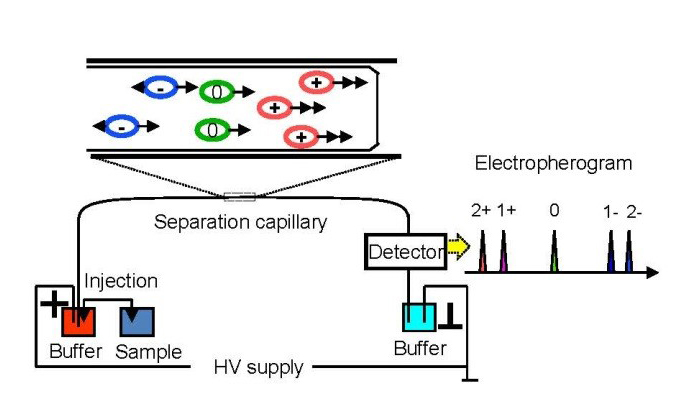WP3: CE-chip platform
Introduction to the field

Capillary electrophoresis (CE) is a high-performance separation technique with benefits like high efficiency, fast analysis and minimal (nL) sample consumption. It also requires very small amounts of reagents, which are usually environmentally friendlyCE is suitable for a wide range of analytes, from small ions to large biopolymers or even cells.
Transferring methods for conventional CE to, and developing novel concepts for, CE-chips brings the additional advantages of CE-chips; their relatively small footprint, their ease of automation and integration, and even faster analysis. All this makes CE-chips with adapted reagents and methods ideal to integrate in a production environment. By using earlier established dynamic or permanent coating technologies for the separation channel, the developed kits will be reproducible and easy to use.

The aim of this part of the project is to develop the CE-chips, together with kits and methods, for integration in the PAOLA, to allow a robust and easy to use analytical tool for instant analysis.
The CE-methods, including kits, and CE-chips developed will generally offer novel tools for fast analysis of a number of important substance groups (amino acids, sugars, lipids, vitamins, Mab aggregates) improving and simplifying analysis in many areas linked to bioanalysis and pharmaceutical production.
More specifically this approach of at-line analysis for cell cultivation monitoring will offer efficient assessment of molecular factors crucial for optimal and high quality biopharmaceutical yield. The unique opportunities to control the cultivation process will in turn contribute to more precise, and time and cost effective production.
WP3 objectives
- To determine the user requirements for the analyses selected, including sample preparation like separation from cells and cell debris, and to gather these in Analytical Target Profiles, ATP, to facilitate expedient analysis
- To determine the analytical possibilities for the use of CE for analysis of samples taken from the cell media and the cell cultures
- To develop prototype CE chips and kits for analysis, and test these kits in the industrial labs. Current assumption is that setups for amino acids, lipids, vitamins, sugars, Mab aggregates and Mab charge variant species will be developed but other medium components and product quality attributes could also be of interest
- To develop CE chips and analysis kits for integration into the iConsensus system
Leader and coleader
Åsa Emmer, Analytical chemistry, KTH
Nienke Vriezen, Synthon
Partners
KTH
Kantisto BV
Micronit
Synthon
Bayer
UCB
Individual scientists
Åsa Emmer, professor, KTH
Saara Mikkonen, PhD, KTH
Cari Sänger, associate professor, Kantisto BV
Debbie van der Burg, MSc, Kantisto BV
Elwin Vrouwe, PhD, Micronit
Marko Blom, PhD, Micronit
Nienke Vriezen, PhD, MBA, Synthon
Ciska Dalm, PhD, Synthon
Stefan Klinker, PhD, Bayer
Jens Traenkle, PhD, Bayer
Alexander Jockver, PhD, Bayer
Christine Mitchell-Logean, PhD, UCB
